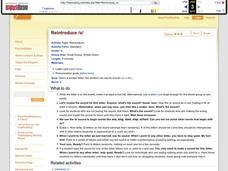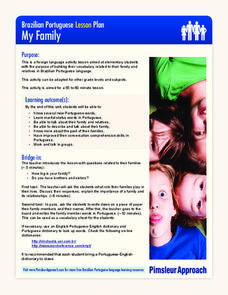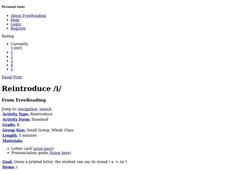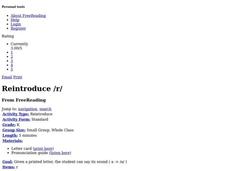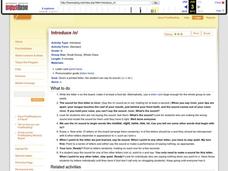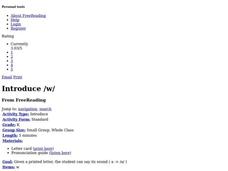Curated OER
Revision Race
Sometimes it's hard to get your English language learners speaking in a natural manner. Print out this board game to provide learners with several opportunities to speak. Everyone gets a chance to participate in this game!
Curated OER
Bingo!
For this bingo worksheet, students participate in a game of bingo that strengthens their use of creative words and phrases not often used in writing.
Get Reading Right
Picture and Word Cards
Reading and recognizing words with the long /e/ sound is enjoyable and accessible for all emerging readers with these picture and word cards. Print, laminate, and play games in small groups or with additional classroom personnel. Two...
Curated OER
Parallelism, Including Correlative Conjunctions and Comparisons
After reading the first reference page about parallel structure using correlative conjunctions, young learners rewrite nine sentences with errors in parallelism. Even the strongest writers in your language arts class could benefit from...
Curated OER
Introduce /o/
The best way to get your scholars familiar with the alphabet is to expose them to each letter in multiple contexts. This strategy incorporates letter recognition, sound, word examples, and pronunciation, and emerging readers will feel...
Curated OER
Reintroduce /s/
What letter is this? As you introduce pre-readers to letter sounds, keep them entertained with this fun game. Start by drawing the letter s on the board, large enough for all to see. Once you've demonstrated the sound it makes, use these...
Pimsleur
My Family
Ensure that your learners can describe their families using Portuguese by following the steps provided here and using the included worksheets and assessments for reinforcement. After a brief introductory activity, learners complete...
Saddleback College
The Wonder of Words
If your language arts students think etymology isn't relevant to their everyday lives, show them a presentation that will prove them wrong! The slideshow provides explanation about various words, roots, and suffixes that have adapted in...
Curated OER
Bats
Use Stellaluna by Janell Canon to discuss bats and other types of animals. Learners identify the differences between bats and birds, list the traits of mammals, create a Bat Facts game, and go on a written scavenger hunt. Fun, clever ideas!
Florida Center for Reading Research
Vocabulary: Morphemic Elements, Root-O!
Young readers get to the root of unfamiliar vocabulary with a collaborative learning activity. Given a deck of root word cards and copies of a graphic organizer, pairs of students take turns flipping over cards and brainstorming...
British Council
Macbeth
Double the fun of studying Shakespeare with an interactive that introduces English learners to Macbeth. After watching a short, animated video that presents key elements of the plot, class members complete a worksheet identifying the...
Curated OER
Introduce /m/
Start by drawing a large letter m on the board for scholars to see. Do they know what letter this is? Once you've demonstrated the sound it makes, use these tips to help them make the same sound. There is even an audio pronunciation...
Curated OER
Introduce /f/
Hook your scholars by drawing a large f on the board; do they know what letter this is? Once you've demonstrated the sound it makes, use these tips to help them make the same sound. Although the audio function is neat, it may not be...
Curated OER
Introduce /u/
As scholars are learning about letter sound correspondence use this activity to help them with the /u/ sound. Learners examine a large u on the board, identifying it if they can. They listen to you make its sound, explaining to them what...
Curated OER
Reintroduce /i/
As your scholars begin learning letters of the alphabet, help them connect sound, pronunciation, word examples, and letter recognition using these strategies. Focusing on the letter i, begin by drawing it on the board. Can scholars...
Curated OER
Reintroduce /f/
Draw a large letter f on the board to begin this letter recognition and sounds activity, asking kids to identify it if they can. Demonstrate the /fff/ sound and explain how you are making it as learners try it out. What words can they...
Curated OER
Reintroduce /r/
The /r/ sound can be a difficult one, but scholars use some helpful tips to get it right. After examining the letter shape they listen to you pronounce this phoneme and describe what you are doing to create the sound. They try on their...
Curated OER
Reintroduce /o/
There are many words that begin with the /o/ sound; scholars study this letter in multiple contexts including intial phoneme examples, pronunciation, and letter recognition. Write the letter on the board to see if learners can identify...
Curated OER
Introduce /n/
What is this letter? Once your class is ready to explore the letter n, use these strategies to combine word examples, pronunciation, and letter recognition. First, can they identify the letter? Make the /n/ sound, explaining how you do...
Curated OER
Introduce /w/
Get to know the ins and outs of the letter w using these strategies combining pronunciation, recognition, letter sound, and word examples. Scholars examine the letter shape and listen to you pronounce the /w/ sound. Use these tips to...
Curated OER
Reintroduce /v/
Combine letter recognition, sound, and pronunciation using this strategy for pre-readers. Use these letter cards or write the letter v on the board, asking scholars to identify it. Then, model the /v/ sound as you explain how you...
Curated OER
Reintroduce /l/
Connect letter recognition, pronunciation, sound, and word examples to give scholars a solid grasp on the letter l. They watch you draw a large l on the board and make the /lll/ sound. Using your tips, they try the sound on their own....
Curated OER
Reintroduce /e/
These inventive strategies help emerging readers focus on the letter e, forming sound associations along with letter recognition. Explain the mouth movement in making the /eee/ sound, asking learners to try it. Can they think of words...
Curated OER
Introduce /y/
As you come to an end in your alphabet study, use these strategies to examine the letter y. Scholars examine the letter shape and listen to you pronounce the /y/ sound. Use these tips to explain how you do it as they try. Can they think...







